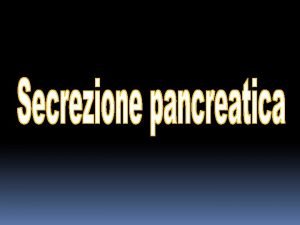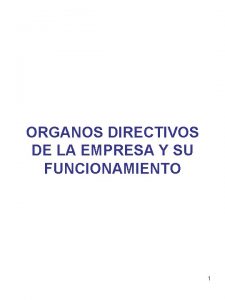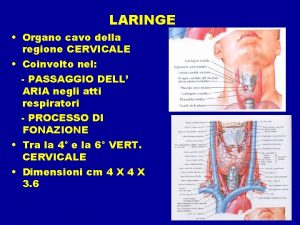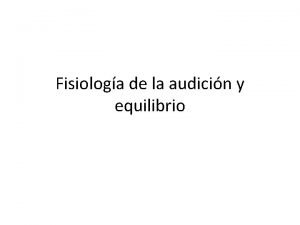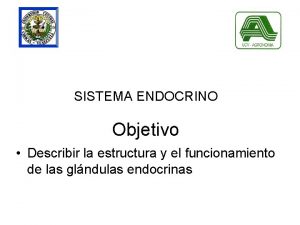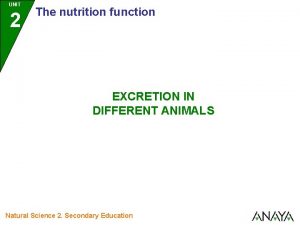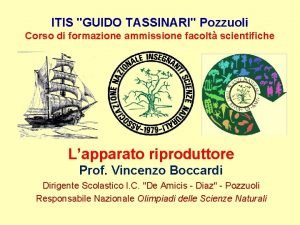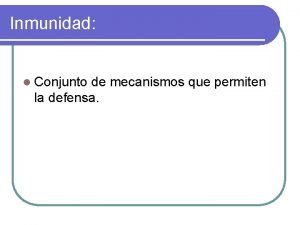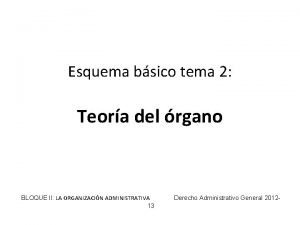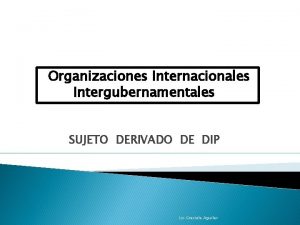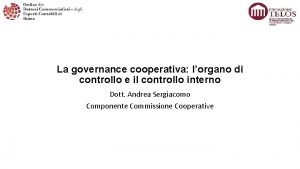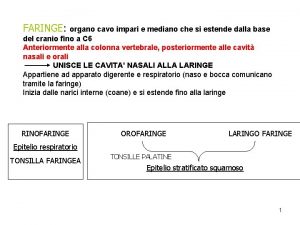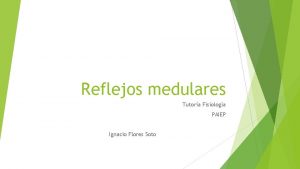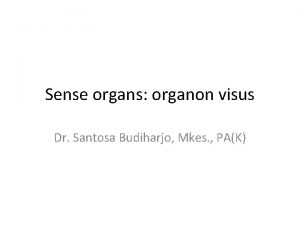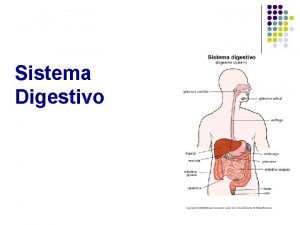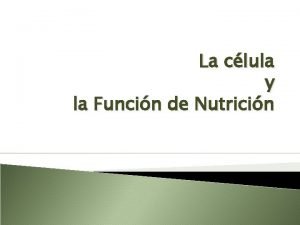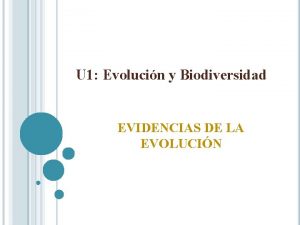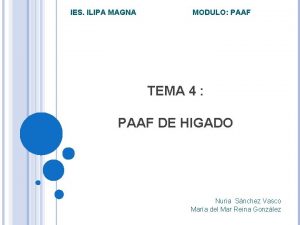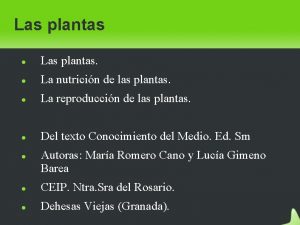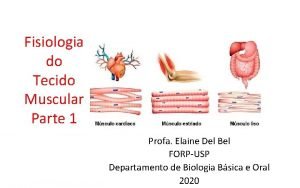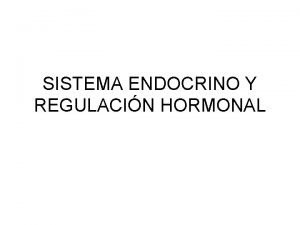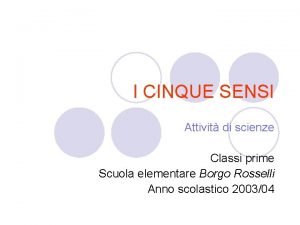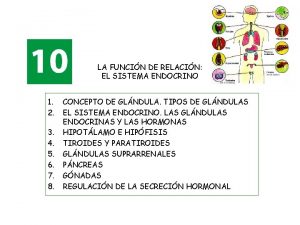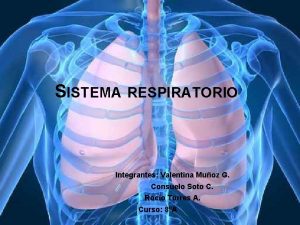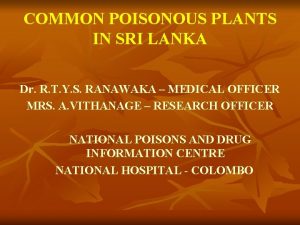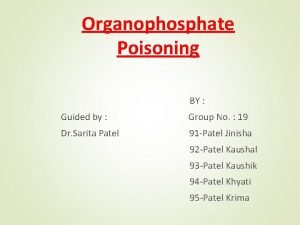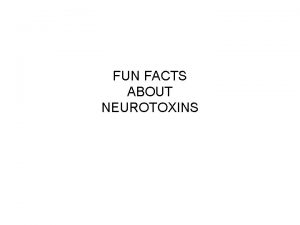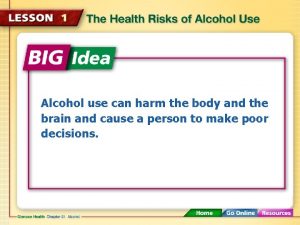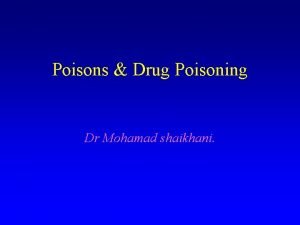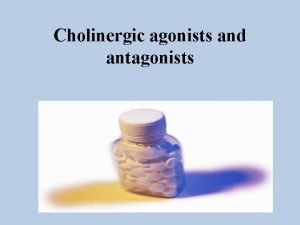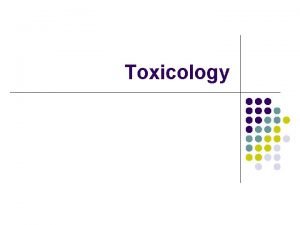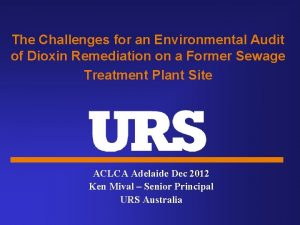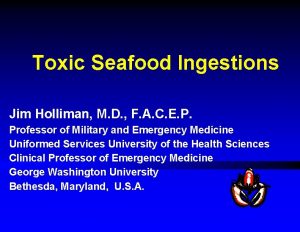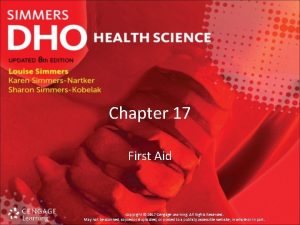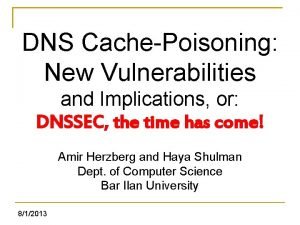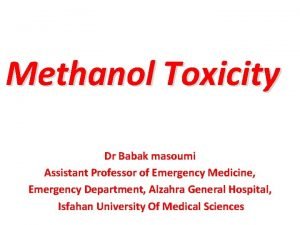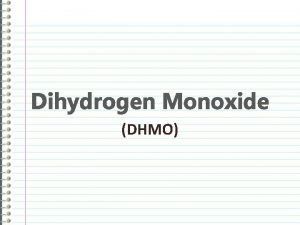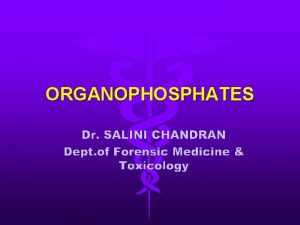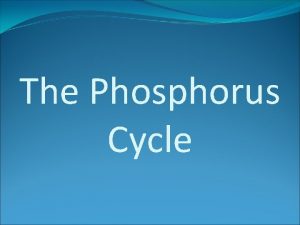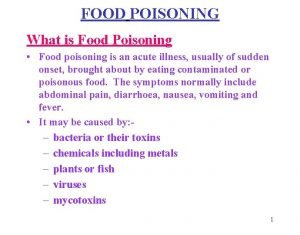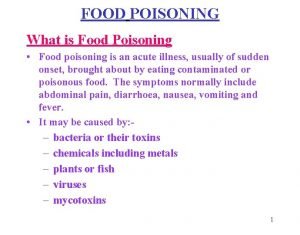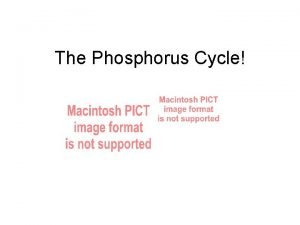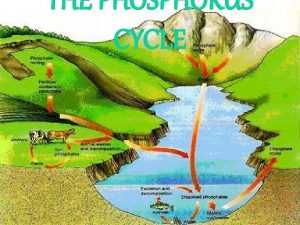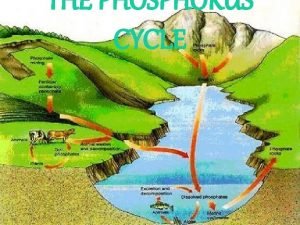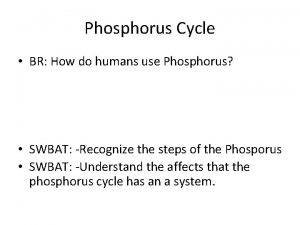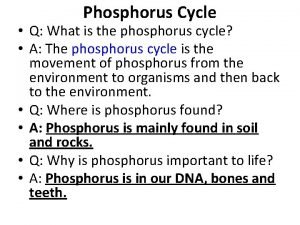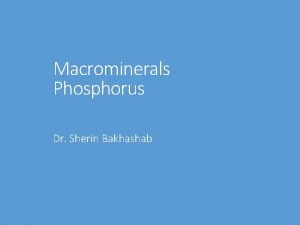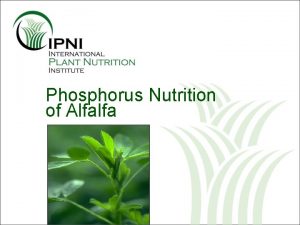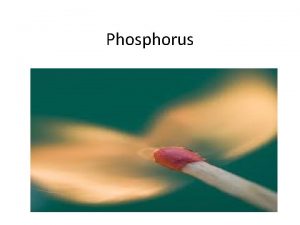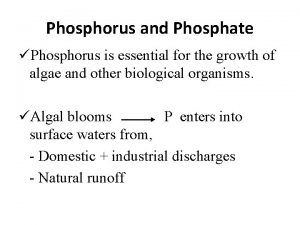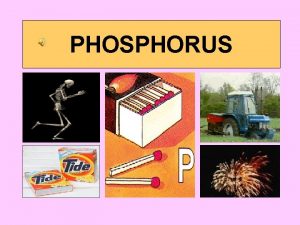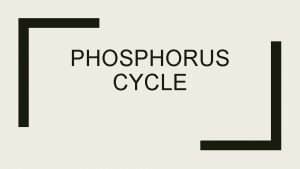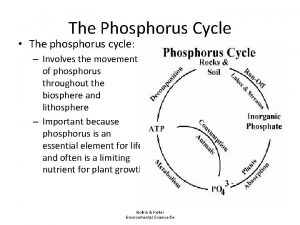ORGANO PHOSPHORUS POISONING Organophosphates are a group of

























































- Slides: 57

ORGANO PHOSPHORUS POISONING

Organophosphates are a group of agents composed of carbon and phosphoric acid derivatives. They are the main component of many agricultural and domestic pesticides. Have been used in the past as an agent of bioterrorism (Tokyo subway, 1995). Common members of this group include sarin (“Nerve Gas”), malathion and parathion.

Examples Insecticides Malathion, parathion, diazinon, fenthion, dichlorvos, chlorpyrifos, ethion, trichlorfo n. Nerve gases Soman, sarin, tabun, VX. Herbicides Tribufos [DEF], merphos are tricresyl phosphate.

Implications of route of exposure on onset of symptoms The route of exposure determines the rapidity of symptom onset. Common routes of exposure are inhalational, skin and ingestional. The inhalational route has the fastest onset, generally within a few minutes of exposure.

In skin exposure, the volume of exposure, intactness of the skin and solubility characteristics of the OP determines lag-time. In ingestional poisoning, symptom onset would depend on the poison load and absorption characteristics.


Features due to overstimulation of muscarinic acetylcholine receptors in the parasympathetic system • Bronchospasm • Bronchorrhoea • Miosis • Lacrimation • Urination • Diarrhoea • Hypotension • Bradycardia • Vomiting • Salivation

Features due to overstimulation of nicotinic acetylcholine receptors in the sympathetic system • Tachycardia • Mydriasis • Hypertension • Sweating Features due to overstimulation of nicotinic and muscarinic acetylcholine receptors in the CNS • Confusion • Agitation • Coma • Respiratory failure

Features due to overstimulation of nicotinic acetylcholine receptors at the neuromuscular junction • Muscle weakness • Paralysis • Fasciculation's


Aging & The Effects of Oxime Cholinesterase Regenerators After organophosphate compounds (including the sarin, soman & VX) bind to the active site on cholinesterase, they can undergo a spontaneous hydrolysis step resulting in the loss of an alkyl side group. The loss of the alkyl side group greatly intensifies the strength of the chemical bond between the phosphate group and the enzyme such that the binding is essentially irreversible. This process is referred to as “aging”, and takes place at different rates for different compounds. Soman: within 10 minutes Sarin: within 3 -5 hours

If a strong “oxime” nucleophile such as pralidoxime (2 -PAM) is given before aging has occurred, it can break the bond between the organophosphate and the enzyme, thereby “regenerating” cholinesterase activity. Once aging has occurred, the bond is much more resistant to the effects of oxime regenerators, and full recovery from their toxic effects requires new synthesis of cholinesterase.

Inhibited acetyl cholinesterase can also become aged, by loss of one of the two alkyl groups attached to the bound phosphate. The half-life of ageing varies according to the inhibiting pesticide: if dimethyl, the half-life is around 3 h; if diethyl, the half-life is around 33 h. Thus ageing has important clinical consequences. If a patient who has ingested a dimethyl pesticide presents to hospital 3 h after ingestion, about 50% of the acetyl cholinesterase will already be aged and unresponsive to oximes. A patient arriving after 12 h will have about 94% aged acetyl cholinesterase and therefore be unresponsive to oximes.


Intermediate syndrome Intermediate syndrome, the best described delayed manifestation, is characterized by paralysis of proximal limb muscles, neck flexors, motor cranial nerves and respiratory muscles 24 -96 h after poisoning, after the cholinergic phase had settled down, with weakness lasting for up to 18 -day. OP’s which are highly lipophilic , persists in fat stores. Re-distribution and re-inhibition of cholinesterase may have delayed symptom onset.

Although intermediate syndrome involves muscle groups, focal weakness has also been reported; in particular, laryngeal paralysis, either acute or delayed by 4 -14 days presenting as "failed extubation. Severe and prolonged diaphragmatic paralysis has also been reported with Malathion poisoning.

Coma is seen in 17 -29% of patients and can last for hours to days. OP poisoning may also present as brainstem stroke. However, some patients manifest altered consciousness or coma days after poisoning, particular after a period of "normal" consciousness. This clinical entity termed delayed organophosphate encephalopathy (DOPE) or "CNS intermediate". Coma with absent brainstem reflexes or encephalopathy has been reported after 4 -day of normal consciousness and spontaneously resolved after another 4 -day. The clinical distinguishing feature between "brain death" and this "mimic" was "small miosed pupils" in patients

Late onset symptoms The classical late onset neuropathy in OP poisoning, OPIDP is characterized by distal weakness that occurs 2 -4 weeks after OP exposure. In a retrospective patient cohort, OPIDP developed in 34. 2% between the 14 th and 22 nd -day following poisoning and was characterized by cramping pain and paresthesias of the extremities followed by weakness of the distal limb muscles, especially in the legs. Electrophysiological changes include reduced amplitude of the compound muscle potential, increased distal latencies and normal or slightly reduced nerve conduction velocities.

Nerve biopsy may show features of axonal degeneration with secondary de- myelination. Recovery is, usually, complete, particularly in the young. However, mild weakness with increase in vibration threshold may persist for 2 -year following acute poisoning. Other late onset features reported include cerebellar ataxia, developing about 5 -week after acute exposure to an OP and extra pyramidal symptoms at 40 -day.

Cholinesterase assays Diagnosis of organo phosphorus poisoning should ideally be confirmed with an assay to measure butyryl cholinesterase activity in plasma (or acetylcholinesterase in whole blood). However, the results of such assays are rarely available in time to affect clinical decision making.

Unfortunately, much confusion exists about the use and interpretation of these assays. Some pesticides inhibit butyrylcholinesterase more effectively than they inhibit acetylcholinesterase. Butyrylcholinesterase activity does not relate to severity of poisoning. However, it can be used as a sensitive marker of exposure to most organophosphorus compounds or other cholinesterase-inhibiting compounds, and for measuring organophosphorus elimination from the body.

Red cell acetylcholinesterase assays These assays measure acetylcholinesterase expressed on the surface of red cells. Red-cell acetylcholinesterase inhibition is a good marker of such inhibition in synapses and of poisoning severity. This enzyme is measured in whole blood in which butyrylcholinesterase activity has been blocked by an inhibitor. Once red-cell acetylcholinesterase has aged, it only recovers via erythropoeisis.

Reactions between acetylcholinesterase, organophosphorus and oximes will continue if a blood sample is left at room temperature after sampling. Blood samples must be diluted and cooled immediately after sampling, to stop the reactions. We routinely dilute by a factor of 20 at the bedside by mixing 200 μL of blood freshly drawn into an EDTA tube with 4 m. L of cold saline (at 4°C) and then place the sample in a freezer at − 20°C within 5 min.

Incubation of an aliquot of blood with a large quantity of oxime (eg, 100 μmol/L obidoxime) for 15 min before assay will reactivate any acetylcholinesterase that has not aged. Such an assay could potentially be used to establish whether a patient might benefit from continued oxime therapy or from higher dose. Monitoring a patient's cholinesterase status after organophosphate poisoning enables the verification of substantial exposure to anticholinesterase agents.

In future, such assays could facilitate the decision about when to stop oxime treatment and allow cautious weaning of a patient from a ventilator when butyrylcholinesterase activity is increasing. Studies are underway to confirm the clinical usefulness of this approach.

TREATMENT Check airway, breathing, and circulation. Place patient in the left lateral position, preferably with head lower than the feet, to reduce risk of aspiration of stomach contents. Provide high flow oxygen, if available. Intubate the patient if their airway or breathing is compromised. Obtain intravenous access and give 1– 3 mg of atropine as a bolus, depending on severity. Set up an infusion of 0· 9% normal saline; aim to keep the systolic blood pressure ˃ 80 mm Hg and urine output ˃ 0· 5 m. L/kg/h.

Record pulse rate, blood pressure, pupil size, presence of sweat, and auscultatory findings at time of first atropine dose. Give pralidoxime chloride 2 g (or obidoxime 250 mg) intravenously over 20– 30 min into a second cannula; follow with an infusion of pralidoxime 0· 5 – 1 g/h (or obidoxime 30 mg/hr) in 0· 9% normal saline. 5 min after giving atropine, check pulse, blood pressure, pupil size, sweat, and chest sounds. If no improvement has taken place, give double the original dose of atropine.

Continue to review every 5 min; give doubling doses of atropine if response is still absent. Once parameters have begun to improve, cease doubling. Similar or smaller doses can be used. Give atropine boluses until 1. Heart rate is ˃ 80 beats per minute 2. Systolic blood pressure is ˃ 80 mm Hg, and 3. Chest is clear (appreciating that atropine will not clear focal areas of aspiration). Sweating stops in most cases.

A tachycardia is not a contraindication to atropine since it can be caused by many factors. The pupils will commonly dilate; however, this sign is not a useful endpoint for initial atropine treatment because a delay exists before maximum effect. However, very dilated pupils are an indicator of atropine toxicity. Severe hypotension might benefit from vasopressors.

Once the patient is stable, start an infusion of atropine giving every hour about 10– 20% of the total dose needed to stabilize the patient. Check the patient often to see if too much or too little atropine is being given. If too little is given, cholinergic features will reemerge after some time. If too much is given, patients will become agitated and pyrexial, and develop absent bowel sounds and urinary retention.

If this happens, stop the infusion and wait 30– 60 min for these features to settle before starting again at a lower infusion rate. Intubate and ventilate patients if 1. Tidal volume is ˂ 5 m. L/kg or 2. Vital capacity is ˂ 15 m. L/kg, or 3. If they have apnoeic spells, or 4. Pa. O 2 is ˂ 8 k. Pa (60 mm Hg) or 5. FIO 2 of ˃ 60%. Continue the oxime infusion until atropine has not been needed for 12– 24 h and the patient has been extubated.

Assess flexor neck strength regularly in conscious patients by asking them to lift their head off the bed and hold it in that position while pressure is applied to their forehead. Any sign of weakness is a sign that the patient is at risk of developing peripheral respiratory failure (intermediate syndrome). Tidal volume should be checked every 4 h in such patients. Values ˂ 5 m. L/kg suggest a need for intubation and ventilation

Treat agitation by reviewing the dose of atropine being given and provide adequate sedation with benzodiazepines. Physical restraint of agitated patients in warm conditions risks severe hyperthermia, which is exacerbated greatly by atropine because it inhibits normal thermoregulatory responses, including sweating. Adequate sedation is therefore important. Diazepam is first-line therapy for seizures; however, seizures are uncommon in well oxygenated patients with pesticide poisoning. Seizures seem to be more common with organophosphorus nerve agents (such as soman and tabun).

Monitor frequently for recurring cholinergic crises due to release of fat soluble organophosphorus from fat stores. Such crises can occur for several days to weeks after ingestion of some organophosphorus. Patients with recurring cholinergic features will need retreatment with atropine and oxime.

Muscarinic antagonist drugs Although atropine remains the mainstay of therapy worldwide, other muscarinic antagonists have been studied in animals. An important difference between such drugs is their penetration into the CNS. Glycopyrronium bromide and hyoscine meth bromide do not enter the CNS, but hyoscine has excellent penetration; atropine enters the CNS, but not to the same degree as hyoscine. The main adverse-effect of atropine is anti cholinergic delirium in patients who receive too high a dose.

However, its poor CNS penetration suggests that it is ineffective at countering coma and reduced respiration seen in patients with the cholinergic syndrome. Hyoscine was used successfully to treat a patient with severe extra-pyramidal features but few peripheral signs. Animal studies suggest that it is more effective than atropine for control of seizures induced by inhaled organophosphorus nerve agents. However, extra-pyramidal effects and seizures are not common features of organophosphorus poisoning.

Gastrointestinal decontamination Gastric lavage is often the first intervention poisoned patients receive on presentation to hospital, sometimes at the expense of resuscitation and giving antidote. No evidence shows any form of gastric decontamination to benefit patients poisoned with organophosphorus. Gastric decontamination should only be done after the patient has been stabilized and treated with oxygen, atropine, and an oxime.

Guidelines for treatment of drug self-poisoning suggest that lavage should be considered only if the patient arrives within 1 hour of ingesting poison. Lavage should probably only be considered for patients who present soon after ingestion of a substantial amount of toxic pesticide who are intubated, or conscious and willing to cooperate. Repeated gastric lavages are recommended in China to remove pesticide remaining in the stomach, although substantial amounts of organophosphorus are unlikely to remain in the stomach after one lavage.

Ipecacuanha-induced emesis should not be used in organophosphorus pesticide poisoning. Patients poisoned with organophosphorus can rapidly become unconscious, risking aspiration if ipecacuanha has been given. Mechanically-induced emesis with large quantities of water risks pushing fluid through the pylorus and into the small bowel, probably increasing the rate of absorption.

A randomized controlled trial of single and multiple doses of super activated charcoal in Sri Lanka failed to find a significant benefit of either regimen over placebo in more than 1000 patients poisoned with pesticides. Because activated charcoal binds organophosphorus in vitro, the absence of effect in patients might be due to rapid absorption of pesticide into the blood. Alternatively, the ingested dose in fatal cases could be too large for the amount of charcoal given, the charcoal might be given too late, or the solvent might interfere with binding. No evidence suggests that patients with pesticide poisoning benefit from treatment with activated

Magnesium sulphate Magnesium sulphate blocks ligand-gated calcium channels, resulting in reduced acetylcholine release from pre-synaptic terminals. A trial in people poisoned with organophosphorus pesticides recorded reduced mortality with magnesium sulphate (0/11 [0%] vs. 5/34 [14· 7%]; p<0· 01). However, the study was small, allocation was not randomized , and the publication incompletely described the dose of magnesium sulphate used and other aspects of the methodology;

Alpha 2 -adrenergic receptor agonist The alpha 2 -adrenergic receptor agonist clonidine also reduces acetylcholine synthesis and release from presynaptic terminals. Animal studies show benefit of clonidine treatment, especially in combination with atropine, but effects in human beings are unknown.

Sodium bicarbonate Sodium bicarbonate is sometimes used for treatment of organophosphorus poisoning in Brazil and Iran, in place of oximes. Increases in blood p. H (up to 7· 45– 7· 55) have been reported to improve outcome in dogs through an unknown mechanism A Cochrane review concluded that insufficient evidence exists at present to establish whether sodium bicarbonate should be used in humans poisoned with organophosphorus.

The roles of haemodialysis and haemofiltration are not yet clear; A recent non-randomized controlled study in China suggested a benefit of haemofiltration after poisoning with dichlorvos, which has poor solubility in fat, and therefore should have a relatively small volume of distribution.

Newer Modalities Butyrylcholinesterase scavenges organophosphorus in plasma, reducing the amount available to inhibit acetylcholinesterase in synapses. It has been cloned and military research now aims to inject soldiers with the enzyme before exposure to organophosphorus nerve gases. Such a prophylactic approach is not practical for self-poisoning with organophosphorus because we cannot predict when a person is going to ingest the pesticide.

Turkish doctors have reported the use of butyrylcholinesterase in fresh frozen plasma to treat poisoned patients. A small controlled study (12 patients given fresh frozen plasma with 21 control patients) recorded benefit, but this trial was not randomized and allocation decisions were unclear. A better approach than use of butyl cholinesterase might be to give recombinant bacterial phosphotriesterases, or hydrolases.

These proteins break down organophosphorus pesticides enzymatically and protect animals from pesticide poisoning. Future clinical development of such enzymes could reduce blood concentrations of organophosphorus, allowing optimum activity of other treatment.

Huperzine Hup. A has been proven to be a powerful, highly specific and reversible inhibitor of acetylcholinesterase. Hup. A has better penetration through BBB , higher oral bioavailability and longer duration of ACh. E inhibitory action. ZT-1 has similar properties to Hup. A. Butane -2, 3 -dionethiosemicarbazone is an oxime with antioxidant properties.

Controversie s AIMS: To explore the efficacy of add-on pralidoxime with atropine over atropine alone in the management of OP poisoning. SETTINGS AND DESIGN: An open-label, parallel-group, randomized clinical trial was conducted in a tertiary care district hospital in West Bengal. MATERIALS AND METHODS: Patients presenting with features of OP poisoning were randomly allocated to receive atropine or atropine-plus-pralidoxime. Efficacy was assessed by analyzing mortality, requirement for ventilator support and the duration of stay in hospital.

RESULTS: During the study period, 150 patients were screened following which 120 patients were randomized to either of the treatment arms. Addon pralidoxime therapy did not offer any appreciable benefit over atropine alone in terms of reducing mortality (18. 33% (11/60) versus 13. 33% (8/60)) and ventilator requirement (5% (3/60) versus 8. 33% (5/60)). However, patients randomized in the add-on pralidoxime arm experienced longer duration of hospital stay (7. 02 ± 1. 12 days) than those receiving atropine-alone therapy (5. 68 ± 1. 87 days) (P < 0. 001)

CONCLUSION: The present study suggested that add-on pralidoxime with atropine therapy did not offer any appreciable benefit over atropine alone in management of OP poisoning. However, further trials are needed to explore different dosing regimens of pralidoxime in order to determine its efficacy in OP poisoning.

A randomized controlled trial in Baramati, India studied the effect of very-high-dose pralidoxime iodide (2 g loading dose, then 1 g either every hour or every 4 h for 48 h, then 1 g every 4 h until recovery) in 200 patients with moderate organophosphorus poisoning (excluding severely ill patients). The high-dose regimen was associated with reduced case fatality (1% vs. 8%; odds ratio [OR] 0· 12, 95% CI 0· 003– 0· 90), fewer cases of pneumonia (8% vs. 35%; 0· 16, 0· 06– 0· 39), and reduced time on mechanical ventilation (median 5 days vs. 10 days).

Laboratory studies to identify the pesticide ingested and degree of baseline acetylcholinesterase inhibition and subsequent reversal were not done. However, this study suggests that large doses of pralidoxime could have benefit if patients are treated early and have good supportive care.

A Cochrane review and two other metaanalyses of pralidoxime have been published. The Cochrane review included two randomized controlled trials and reported no clear evidence of benefit or harm.

Two randomized controlled trials in Vellore, India in the early 1990 s noted that low-dose infusions of pralidoxime might cause harm. The absence of clinical benefit could relate to trial design (suboptimum dose, or bias in allocation). Alternatively, this result could suggest that pralidoxime is ineffective in the patients seen at this hospital, perhaps because of the specific pesticide ingested, the amount ingested, or the patients' long delay before pralidoxime is given.

WHO recommends that oximes be given to all symptomatic patients who need atropine. To ensure a therapeutic concentration, a loading dose of pralidoxime chloride or obidoxime is given, then a continuous infusion. The loading dose of oxime should not be given rapidly as a bolus because this method causes vomiting (risking aspiration), tachycardia, and diastolic hypertension

THANK YOU….
 Mikael ferm
Mikael ferm Arco reflejo miotatico
Arco reflejo miotatico Organo desconcentrado y descentralizado diferencias
Organo desconcentrado y descentralizado diferencias Procarbossipeptidasi
Procarbossipeptidasi Organo directivo de una empresa
Organo directivo de una empresa Cartilagini cuneiformi
Cartilagini cuneiformi Organo de corti
Organo de corti Organo diana que es
Organo diana que es Organo
Organo Tassinari pozzuoli
Tassinari pozzuoli Il governo è un organo complesso
Il governo è un organo complesso Aparato reproductor masculino
Aparato reproductor masculino Ganglio linfatico
Ganglio linfatico Organos administrativos
Organos administrativos Diplic
Diplic Organo wood
Organo wood Organo di controllo srl
Organo di controllo srl Organo impari
Organo impari Organo gold top earners
Organo gold top earners Organo tendinoso de golgi y huso muscular
Organo tendinoso de golgi y huso muscular Lagopthalmus
Lagopthalmus Governo organo costituzionale
Governo organo costituzionale órgano muscular expandible que fabrica jugo gástrico
órgano muscular expandible que fabrica jugo gástrico Características de la piel
Características de la piel Organo tendinoso de golgi y huso muscular
Organo tendinoso de golgi y huso muscular Dibujo de la savia bruta y elaborada
Dibujo de la savia bruta y elaborada Il governo è un organo complesso
Il governo è un organo complesso Parentesco entre
Parentesco entre Alto organo giudiziario
Alto organo giudiziario Organo de corti
Organo de corti Organo higado
Organo higado El aparato reproductor masculino
El aparato reproductor masculino Nivel de organo
Nivel de organo Fotosíntesis proceso
Fotosíntesis proceso Definição de tecido
Definição de tecido Organo diana de la adrenalina
Organo diana de la adrenalina Il naso e l'olfatto scuola primaria
Il naso e l'olfatto scuola primaria Qué es el poder judicial
Qué es el poder judicial Sistema endocrino
Sistema endocrino Cuales son los componentes del aparato respiratorio
Cuales son los componentes del aparato respiratorio Kaneru gedi
Kaneru gedi Organophosphate poisoning
Organophosphate poisoning Golden poison dart frog
Golden poison dart frog Food poisoning
Food poisoning Alcohol poisoning
Alcohol poisoning Dose of atropine in op poisoning
Dose of atropine in op poisoning Neminath hubballi
Neminath hubballi Gastrozepin
Gastrozepin Suicidal attempt icd 10
Suicidal attempt icd 10 Pyrethroid poisoning
Pyrethroid poisoning Ld 50
Ld 50 Dioxin poisoning
Dioxin poisoning Clupeotoxin
Clupeotoxin Chapter 17:6 providing first aid for burns
Chapter 17:6 providing first aid for burns Dns cache poisoning attack tutorial
Dns cache poisoning attack tutorial Prinso poisoning
Prinso poisoning Methanol poisoning
Methanol poisoning Dh-mo-1
Dh-mo-1



